Black Friday is just a few weeks away, landing on November 28, and Superior Engineering has deals that matter for anyone who actually uses their 4WD.
Whether you’re heading off the beaten track, strengthening a work ute, or fixing weak points on your weekend rig, this is a good time to plan your upgrades. Parts move fast, so it pays to check what you need ahead of time. Fitment information is available online, and the team can help if you’re unsure what will suit your vehicle. Getting your 4WD ready before your next trip is simple if you plan early.
What’s on sale?
- 15% off all Superior Engineering products: Suspension, shocks, lift kits, bar work, bull bars, protection gear and upgrade packages.
- 10% off selected leading 4WD brands: Including some of the most trusted names in the industry.
Why upgrade?
- Suspension and lift kits: Better ride, improved load handling and safer off-road performance. Designed for Australian conditions and tested by people who actually drive off-road.
- Underbody protection: Bash plates, diff guards and full underbody systems protect vital drivetrain parts. Superior’s items are built tough and designed to fit lifted vehicles.
- Bull bars and barwork: Compliant, strong barwork adds safety and recovery points while standing up to off-road use.
Cyber Monday
Missed Black Friday? Cyber Monday on December 1 is another chance to get 15% off Superior Engineering products, plus 10% off selected trusted brands. Stock is limited, so shop early.
Sale details
- Starts: 27/11
- Ends: 1/12
- Stock: Limited; popular items sell out quickly.
- Exclusions: Some brands are not included – see Sales Terms and Conditions.
If your 4WD needs upgrades that actually stand up to real use, now’s the time to make a plan. Shop early to make sure you get the gear you need before stock runs out.
When you’re setting up a 4×4 for serious touring, wheels don’t always top the shopping list.
Suspension upgrades, extended fuel range, electrical setups and storage solutions usually steal the spotlight. But if you’ve ever pushed a vehicle across remote tracks, you’ll know just how critical the right rims can be. When I upgraded the GVM on my Isuzu D-MAX, I hit that realisation hard – the factory alloys simply weren’t up to the task. They weren’t rated to handle the extra load that comes with carrying all the gear needed for remote travel and, worse still, if I wanted a replacement, Isuzu wanted $1250 per rim.
I prefer to tour with six wheels – four on the vehicle and two spares – which would have been an eye-watering outlay. That sent me looking for alternatives, and I landed on Mullins Wheels, which has a strong reputation for rugged, Australian-spec rims. I settled on the CSA-X Recoil, ordering six in 18×8.5, 6/139.7 stud pattern, +20 offset, finished in Satin Black.
Why choose the CSA-X Recoil?
The decision was pretty simple once I started digging into the specs. The CSA-X Recoil is designed for heavy-duty applications, particularly for vehicles that have undergone a GVM upgrade like mine. Each rim carries a hefty 1500kg load rating, making it a bulletproof choice for serious off-road work. Whether you’re tackling rough tracks or hauling a fully loaded 4×4, they’re an obvious pick if you’ve gone to the trouble of upgrading your GVM.
Then there was the value for money. Compared with the astronomical price of the OEM Isuzu alloys, I could buy a full set of six CSA-X Recoils for far less than four factory rims. That alone made the decision easy – but the bonus is that they look great, too. The Satin Black finish suits the D-MAX perfectly and gives it a tougher stance without being flashy.
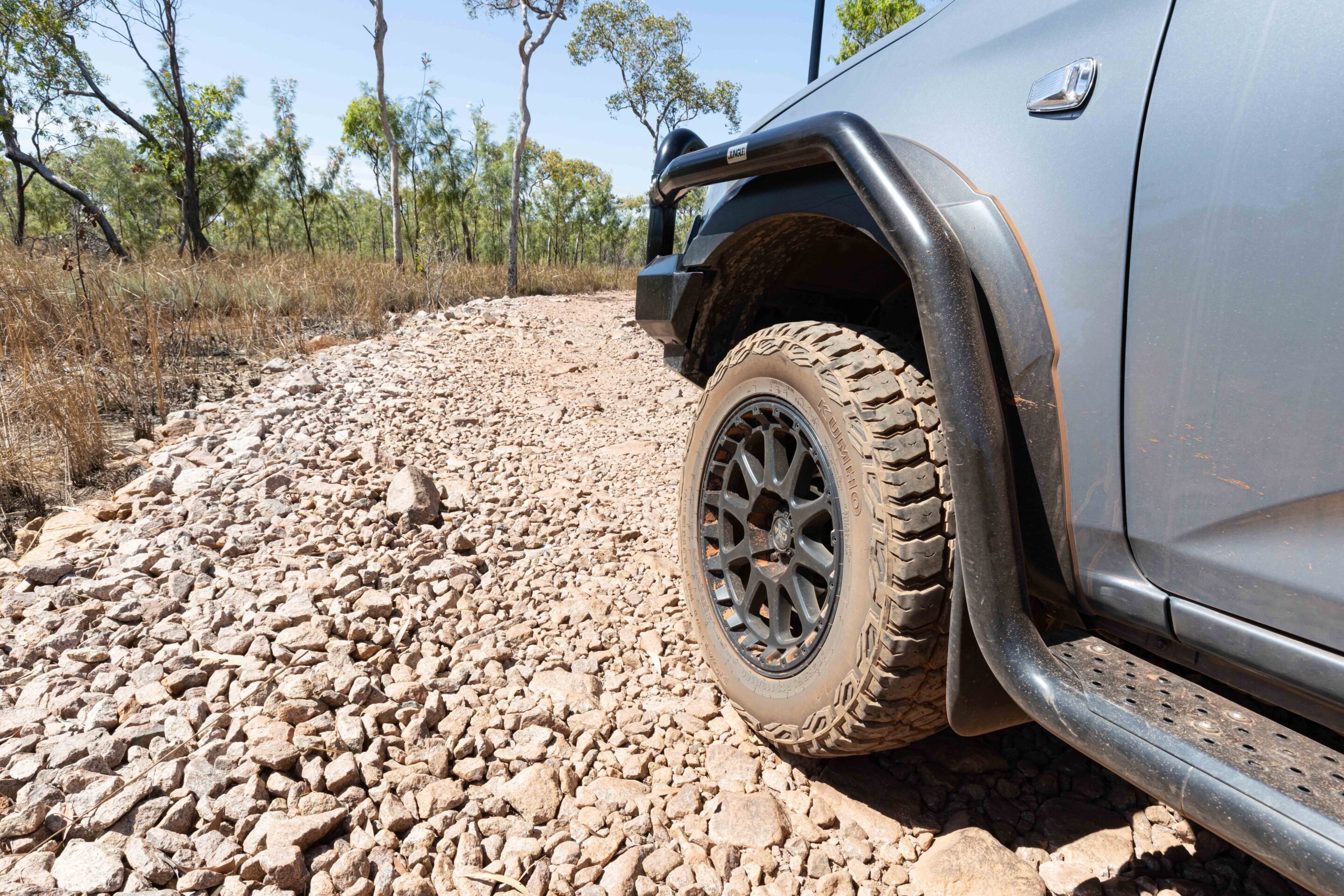
A century of experience
Another factor that swayed me was Mullins Wheels’ history. It has been operating for more than 100 years and remains one of the most trusted names in the Australian wheel market. Its CSA (Custom Styling Alloy) range is engineered with local conditions in mind, and the Recoil has been tested and rated for the realities of heavy touring rigs – not just for looks or light work. That gave me confidence I wasn’t taking a gamble on an unproven brand.
Real-world tests
This wasn’t a driveway impression or a city-based product test. I’ve now put the CSA-X Recoils through thousands of kilometres across some of Australia’s toughest and most varied terrain.
Victorian High Country
This region is a proving ground for both vehicles and drivers. Long climbs, rocky ledges, steep descents and constant tyre-placement challenges can quickly expose weak points. The Recoils shrugged off the punishment. Even after regular scrapes against rocks, they stayed true, with no signs of warping or cracking.
On remote desert tracks, corrugations are relentless. The pounding can shake a vehicle to bits and has been known to crack alloy wheels that aren’t up to the task. The Recoils held firm. I didn’t need to stop and check them or worry about fatigue – they just kept rolling.
Canning Stock Route
If you want a test that covers it all, the Canning provides it: deep sand, endless bulldust, rocky jump-ups and more corrugations than you can imagine. Over two weeks on the CSR, the Recoils performed flawlessly. The peace of mind that comes from knowing your wheels are up to it lets you focus on driving and navigation, not whether your gear will fail.
Mary River and Litchfield National Parks
Up in the Top End, the challenges are different – mud, sand, sharp creek crossings and plenty of red dirt. The Satin Black finish cleaned up easily afterwards and showed only the expected light scuffs you’d pick up anywhere. Structurally, there were no issues at all.
Through all these conditions, what impressed me most was how little I had to think about the wheels. They did their job without fuss – exactly what you want from equipment you rely on in remote areas.
Why do I run six wheels?
Some travellers reckon two spares is overkill, but for me it’s insurance. When you’re hundreds of kilometres from the nearest town, tyre damage is almost inevitable. Having two spares on board means I can keep pushing forward rather than turning back or sitting around waiting for a rescue. The CSA-X Recoils made this setup affordable – without compromising strength.
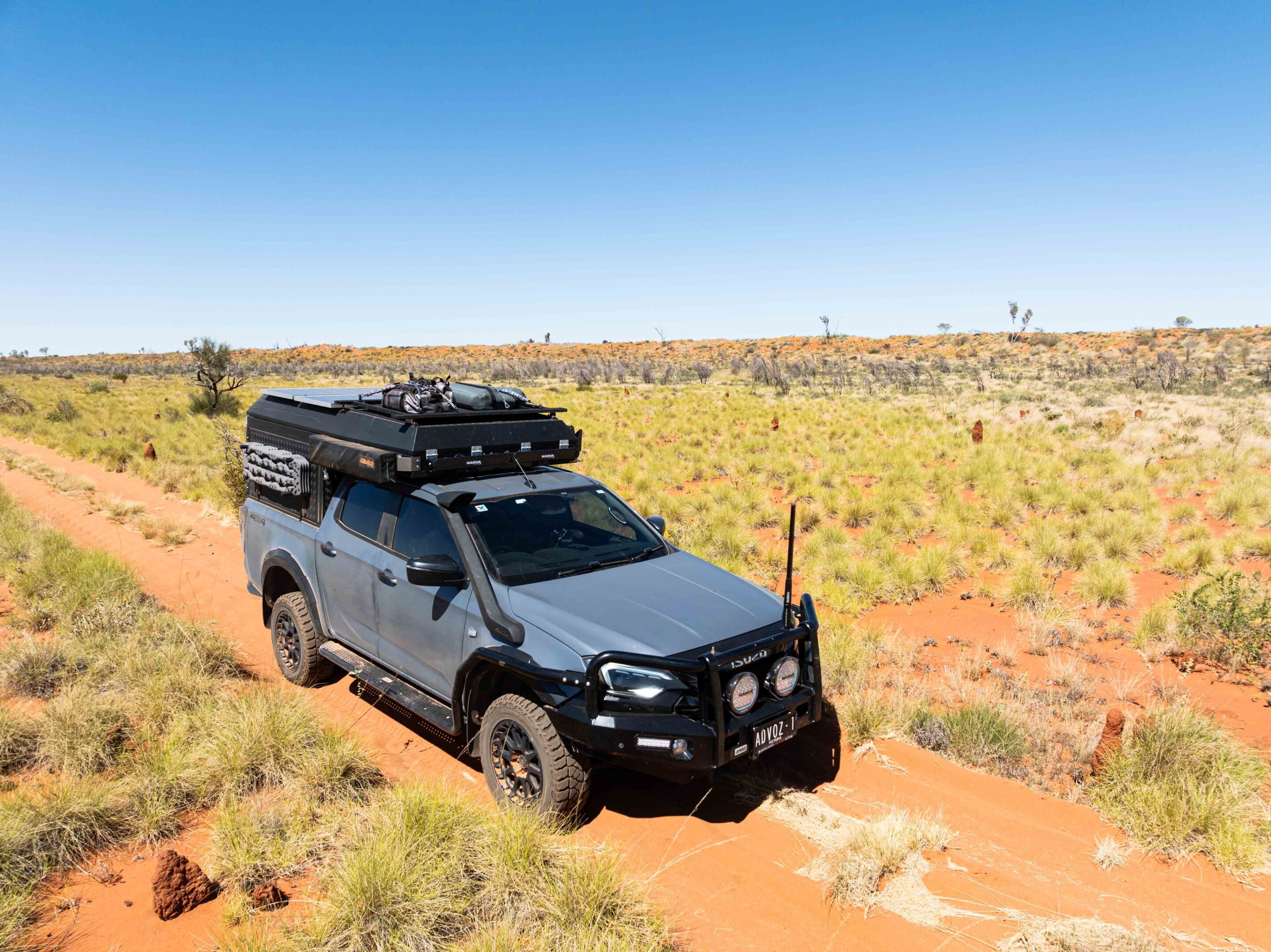
Durability and finish
After thousands of kilometres of dust, mud, rocks and corrugations, the Satin Black finish has held up well. There are a few honest stone chips, but no peeling, fading or corrosion. The design makes it easy to wash out clay and grit, and they still look sharp once cleaned up. Structurally, they’re as solid as the day I fitted them – no cracks, no loss of roundness, and no signs of fatigue.
Who are they for?
The CSA-X Recoil rims are ideal for anyone who takes their 4×4 beyond the city limits – especially those who’ve invested in a GVM upgrade. If you regularly carry heavy loads, tow a van or head off on long remote trips, these rims will give you confidence that your wheels aren’t the weak link.
For those who mostly stick to bitumen and only tackle the odd dirt road, they might be overkill – but if serious touring is on your radar, they make a lot of sense.

Verdict
The CSA-X Recoil rims have proven their worth across everything from High Country climbs to desert corrugations and Top End mud. They’re strong, practical and great value, giving me the confidence to tour fully loaded without worrying about rim failures.
Would I recommend them? Absolutely. After thousands of kilometres, they’ve earned my trust. If you’re planning long-distance adventures or heading down the path of a GVM upgrade, the CSA-X Recoils from Mullins Wheels are a smart, dependable choice.
Specs
| Mullins Wheels: CSA-X Recoil | |
|---|---|
| Size | 18×8.5 |
| Stud Pattern | 6/139.7 |
| Offset | +20 |
| Finish | Satin Black |
| Load Rating | 1500 kg |
| Manufacturer | Mullins Wheels (CSA brand) |
| Quantity Fitted | 6 (four plus two spares) |
| RRP | From $340 each (varies by retailer) |
Tambo in central Queensland is one of those towns many travellers breeze through without a second thought.
I’d been guilty of it myself, thinking it was just another quiet country outpost. But Tambo is, in fact, the oldest town in Central Western Queensland, settled in 1863 as an important stopover for drovers seeking new pastoral country. Before explorer Sir Thomas Mitchell passed through in 1846, following local river systems, the Dharawala people roamed the area.
Originally called Carrangarra, the town’s name was changed to Tambo in 1868. The pub – still bearing the original name – was first built in 1865, has burned down three times, and once served as the post office. For the next 50 years, Tambo thrived as a service hub for the surrounding region. Today, it still has a strong pastoral industry alongside a growing tourism trade.
Tambo sits on the Barcoo River, 860km north-west of Brisbane in central Queensland, and it’s well worth a few hours to explore. You can wander its historic buildings, stroll the Coolibah Walk, check out the transport museum or drop into Tambo Teddies. The Visitor Information Centre has a brochure outlining 17 heritage sites, each with its own story. On the edge of town, the dam – built in 1880 as Tambo’s water supply until bores tapped the Great Artesian Basin in 1895 – now teems with native birds, fish and insects.
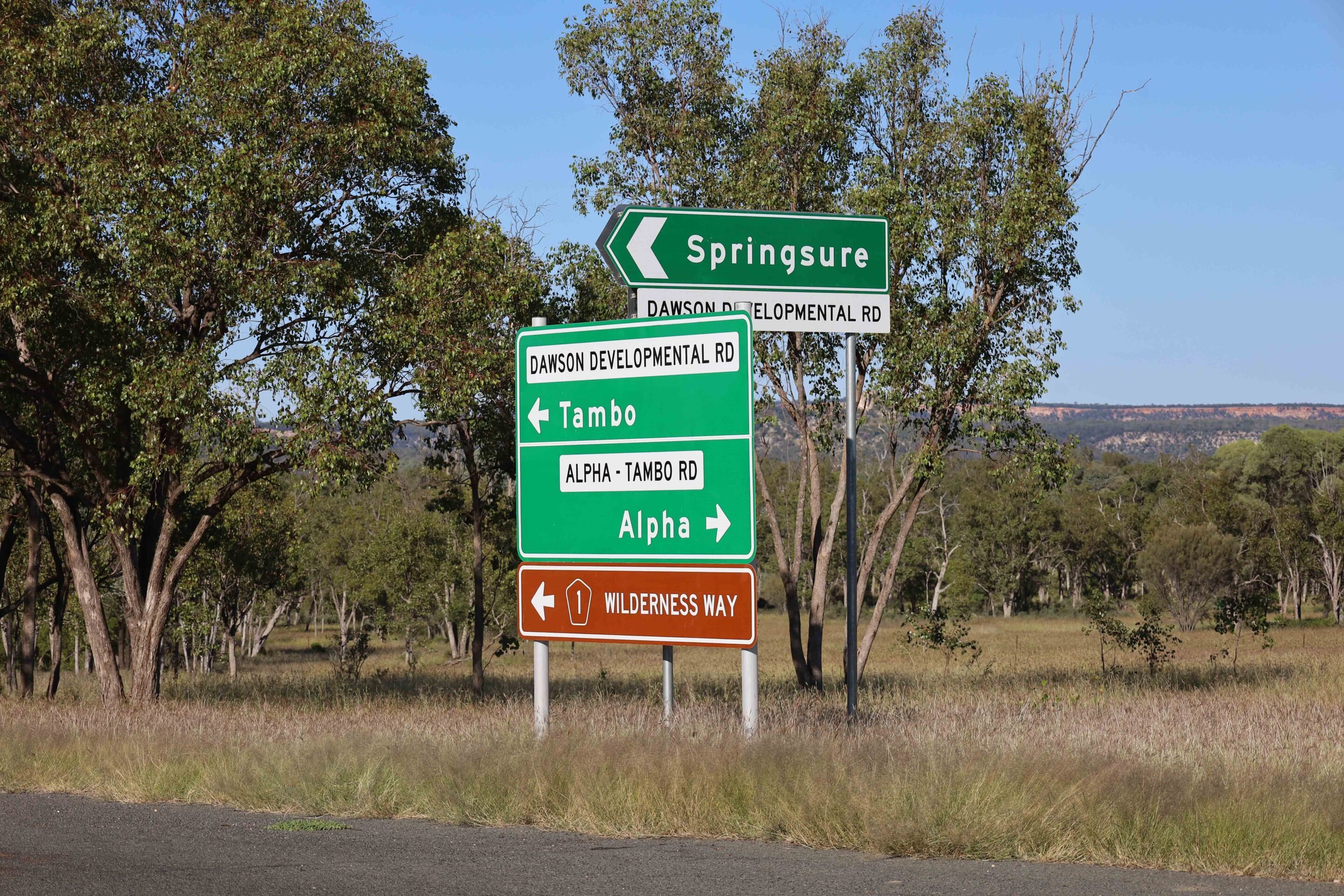
Local highlights
These days, Tambo is best known for Tambo Teddies – a local brainwave from 1992, when wool prices crashed and the town needed a new source of income. Thirty-three years on, more than 50,000 handcrafted bears have been sold around the world.
Just down the road, the Wild and Woolly Tambo Truck and Transport Museum was created in 2012 to celebrate the days when wool was king. Built around a 1944 Johnson Brothers freight truck, the display uses reclaimed materials from the district and is packed with memorabilia from the town’s long transport history. It charts the evolution of freight in the outback – from horse-drawn carriers of the 1860s, to the first motorised trucks of the 1920s, to today’s modern fleets.
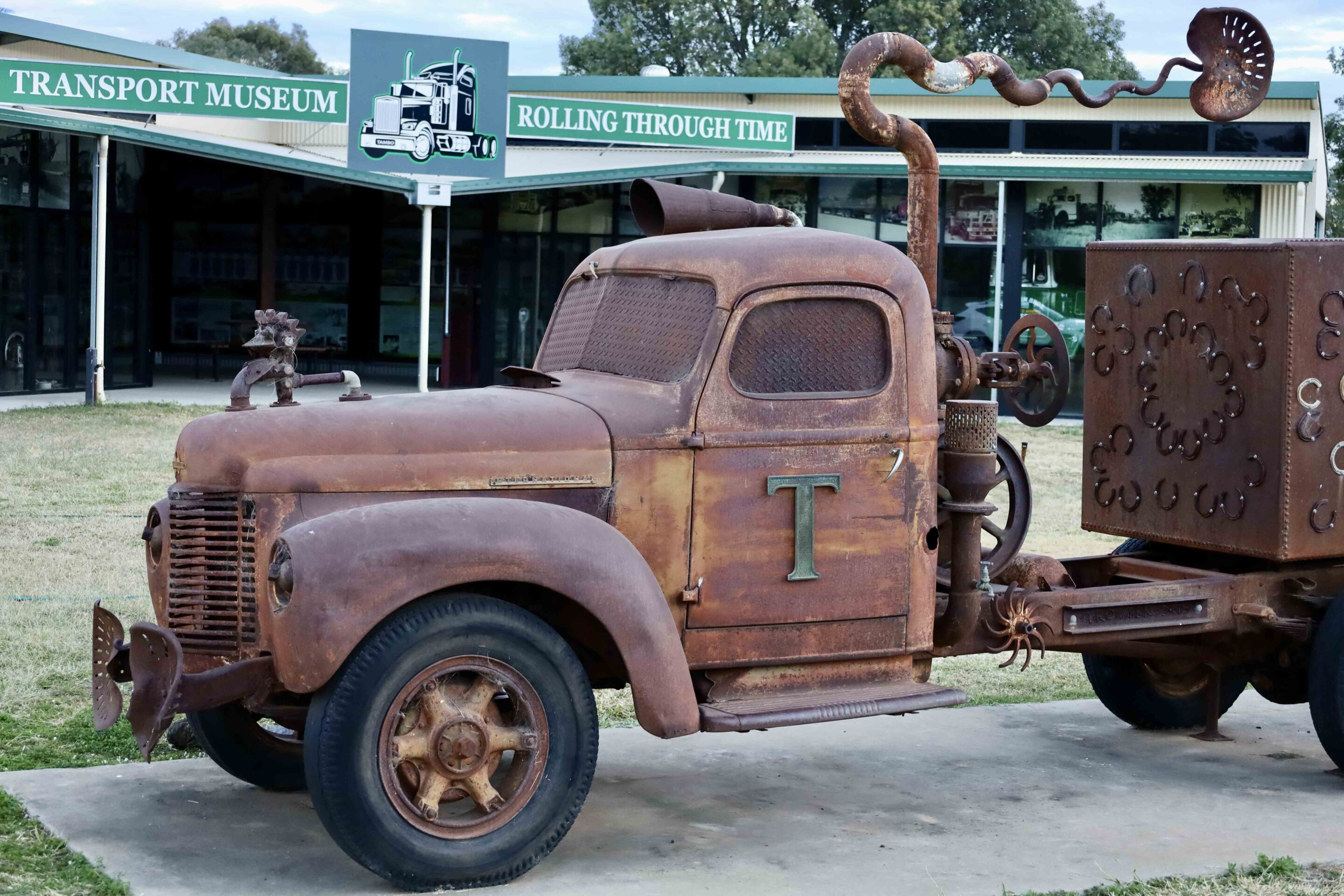
The Wilderness Way
After a few hours in town, I set out on a scenic 4×4 run called the Wilderness Way, linking Tambo to Springsure 250km to the north. My starting point was Windeyer, 40km out of Tambo, where the Dawson Development Road turns right and the bitumen gives way to dirt.
The route is often described as suitable only for high-clearance 4x4s – but on my run, the road was in top shape and barely a challenge. This self-drive tour skirts the western side of Carnarvon Gorge and Salvator Rosa National Park, offering spectacular views of sheer cliff lines, striking rock formations and rugged mountain country. Midway along, Bull Creek Vista is a great spot to stretch the legs, with views east to the sandstone outcrops of Autograph and Stool Rock, and a solitary pillar known as The Monument.
An hour further on, at the intersection of Cungelella Road, a monument marks where Major Thomas Mitchell passed through in 1846 while trying to unravel the mystery of Australia’s river system – and whether an inland sea existed. Mitchell named the nearby Salvator Rosa valley after a famous Italian painter, christened the Claude River, and identified the rich Mantuan Downs pastoral plains. Crossing those plains, he discovered entire petrified trees. His explorations also took him east, where he charted the Belyando and the entire Barcoo River system.
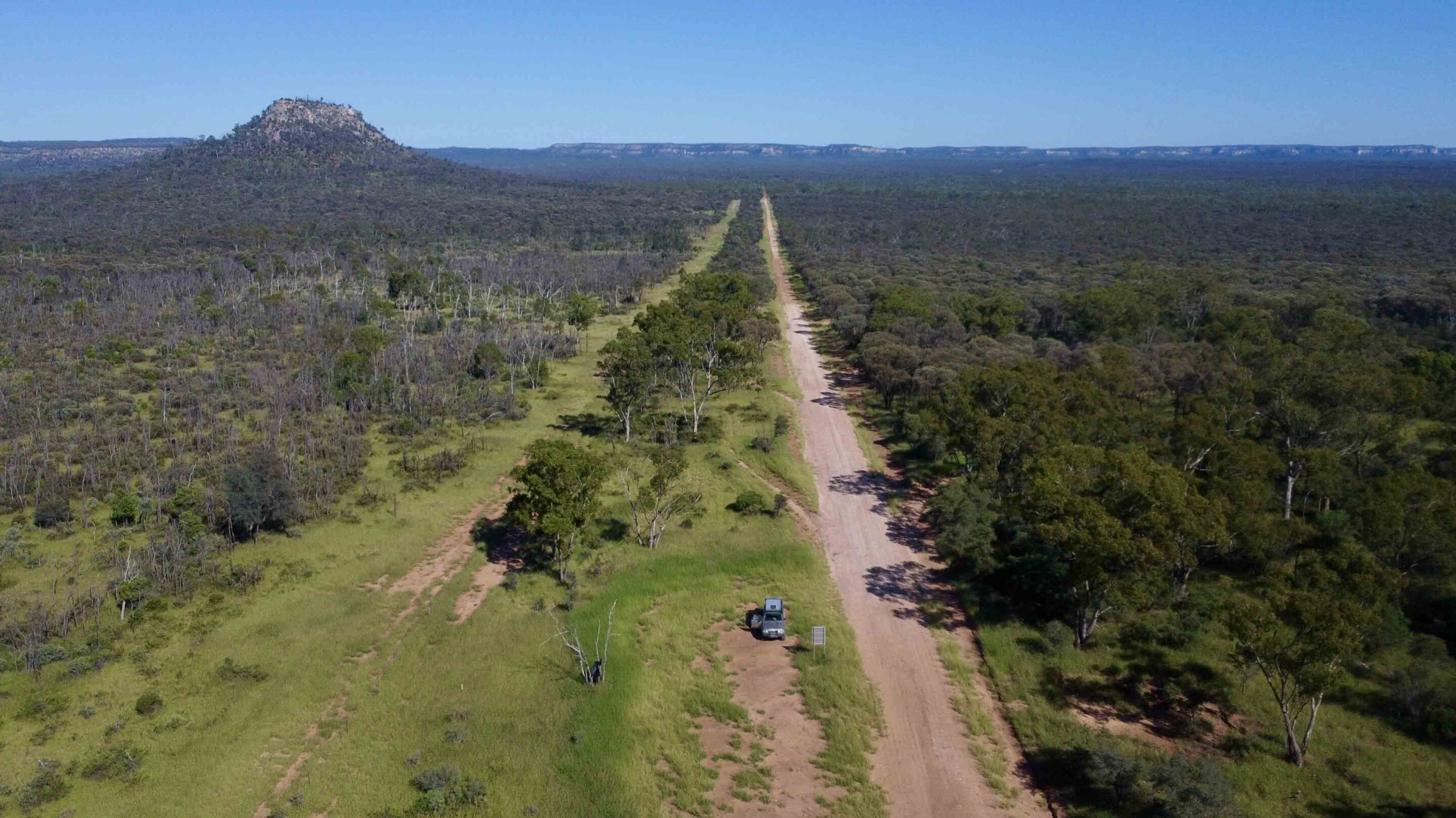
Cungelella Road leads into the remote Salvator Rosa National Park, where you can camp in solitude, tackle remote hikes and spot a wide variety of wildlife. For those heading off on foot, Queensland Parks asks hikers to complete a Remote Bushwalking Advice form and leave it with a responsible contact – the park’s rugged terrain and inhospitable country demand respect. One of its most remarkable features is the network of clear springs that feed more than 10 million litres of water a day into nearby creeks, seeping under the Central Queensland Sandstone Belt to form the headwaters of local rivers.
Heading back along the Dawson Development Road towards Springsure, the landscape opens into rolling pastoral country dotted with majestic bottle trees. Before long, the township comes into view, with plenty to see and do. Minerva Hills National Park offers sweeping views and the chance to see ancient volcanic plugs, while the Springsure Museum is crammed with 150 years of local memorabilia. You can even camp beneath the towering Virgin Rock and watch it dramatically lit at night.
I’ve only scratched the surface of this stunning stretch between Tambo and Springsure – there’s far more to uncover, from natural wonders and living museums of cultural history to some of the best remote driving roads central Queensland has to offer.

Essential information
Where
Tambo’s Wilderness Way is a remote self-drive route that can be tackled as a 270km loop or as an adventure drive between Tambo and Springsure in central Queensland. It can be done in a SUV in dry conditions, but a 4×4 is recommended – especially after rain, when sections may become impassable. Settled in 1863, Tambo is the oldest town in Western Queensland and a living museum of pastoral history. It’s located 580km west of Bundaberg on the Landsborough Highway.
Things to see
Tambo’s main street is lined with historic buildings, a transport museum and the oldest pub in Western Queensland. The Wilderness Way – known as the ‘Rooftop of Queensland’ – delivers sweeping views of deep gorges and towering cliff lines, with sharp sandstone ranges the highlight through Salvator Rosa National Park. Depending on your plans, you can camp in the park, push on to Springsure or loop back to Tambo. And while you’re in town, don’t miss the famous Tambo Teddies – handcrafted here since 1993.
More information
Tambo’s main street is rich in history, with information boards at nearly every heritage building. The Outback Queensland website has basic self-drive details for the Wilderness Way, or you can drop into the Tambo Museum at 10 Arthur Street for a deeper dive into the region’s past.
In an attempt to recreate Range Rover’s 2018 viral moment on Tianmen Mountain, Chery has managed the opposite – with videos circulating online showing a Fengyun X3L test going sideways.
During a performance run on the mountain’s famed “Stairway to Heaven,” the SUV reportedly slid backwards after a seatbelt hook detached and wrapped itself around the right wheel, cutting power and sending the vehicle into an ancient handrail. Chery has apologised, confirmed no injuries, promised to repair the damage, and acknowledged the shortcomings in its approach.
“The outcome has exposed our insufficient assessment of potential risks and lapses in detail control during the planning and execution of this test. In particular, we deeply reflect on the public concerns caused by choosing to conduct the test in a public scenic area,” Chery reportedly said in a statement.
The choice of venue hasn’t helped. Tianmen Mountain is a protected 5A national attraction, and the 999-step staircase leading to the Heaven’s Gate arch is considered a sacred site – making the mishap even more awkward for the brand.
It all harkens back to Range Rover’s 2018 spectacle, when a Sport P400e successfully climbed the 11.3-kilometre Dragon Road and powered up the same staircase under tightly controlled conditions.
That stunt went global; Chery’s attempt is doing the rounds for entirely different reasons.
The upcoming Ford Ranger Super Duty is set to hit the market sooner than expected, with customer deliveries starting later this year.
In announcing the expedited launch, Andrew Birkic, President and CEO of Ford ANZ, also shared the program’s origins and progress in a detailed LinkedIn post, highlighting how the truck was designed to meet real-world Australian needs.
The idea for the Ranger Super Duty began six years ago, when Ford’s truck leadership met with one of the country’s largest fleet operators to understand what worked – and what didn’t – with existing mid-size utes. As Birkic explained in his post, fleets were spending time and money modifying vehicles to handle heavy workloads.
“Walking out, the mission was clear. Our heavy duty customers needed a mid-size truck that could carry almost two tonnes of payload, tow up to 4.5 tonnes, and be incredibly capable off-road. Nothing existed in the Australian market that could do all this, backed by a full factory warranty,” stated Birkic.
From there, the project gained momentum. Ford’s Australian engineering team, drawing on decades of local experience, took the lead in applying the Super Duty nameplate outside North America for the first time. The goal was to deliver a mid-size truck with genuine heavy-duty capability.
“Fast forward to the past few months, where I’ve been hitting the road in a prototype Ranger Super Duty across regional Australian roads,” Birkic posted. “It wasn’t about testing its outright capability; it was about getting it into the hands of the people who’d rely on it day in and day out – dealers, farmers, mechanics, construction companies, mining teams and your everyday Aussie.”
Birkic says the vehicle is shaping up to be a game changer for operators who need a mid-size ute that can handle serious loads and challenging conditions without requiring extensive modifications.
“This is more than a new model; it’s a solution born from deep listening. And I’m incredibly proud to announce the Ranger Super Duty is arriving ahead of schedule, with customer deliveries starting later this year,” he said.
All Super Duty models will be powered by a 3.0-litre V6 turbo-diesel engine producing 154kW at 3250rpm and 600Nm of torque at 1750rpm, with heavy-duty truck calibration meeting EU VI emissions standards. A 10-speed automatic transmission and full-time 4WD is standard across the range.
For Jimny owners looking to get the most out of their 4×4, Superior Engineering offers a suite of upgrades designed to boost durability, handling and off-road capability.
Whether you’re tackling rocky trails, soft sand or muddy tracks, these five products are essential for protecting your vehicle and improving its performance 👇
1. Steering Links
The stock drag link on the Jimny is a weak point once larger tyres or a suspension lift are added. Superior Engineering’s steering link replaces it with a solid 1020‑grade steel bar, providing significantly greater strength and rigidity. It bolts directly to factory mounting points and features an adjustable length to restore correct steering geometry and wheel centring after modifications. With a corrosion‑resistant zinc coating, it’s built to handle heavier steering loads and resist flex on challenging terrain, improving durability and steering precision compared to standard components.
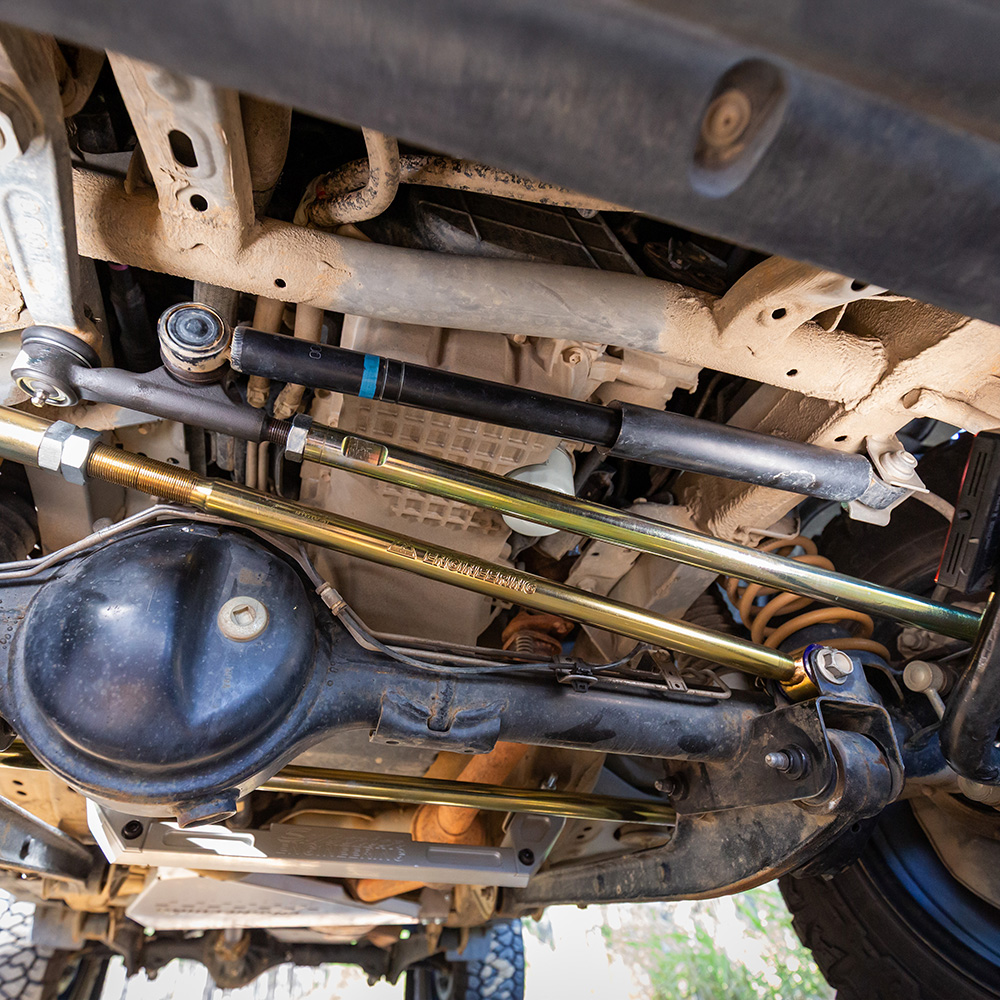
2. Shocks
A key to maintaining control and comfort off-road, the Superior Engineering Monotube IFP shocks deliver consistent damping under load. Tuned specifically for the Jimny’s weight and dynamics, they fit both factory-height and lifted vehicles with larger tyres. Heavy-walled tubes, chrome piston rods, and a corrosion-resistant finish ensure long-term durability, while the bolt-on design makes installation straightforward. The result is enhanced ride quality, stability, and longevity both on and off the beaten track.
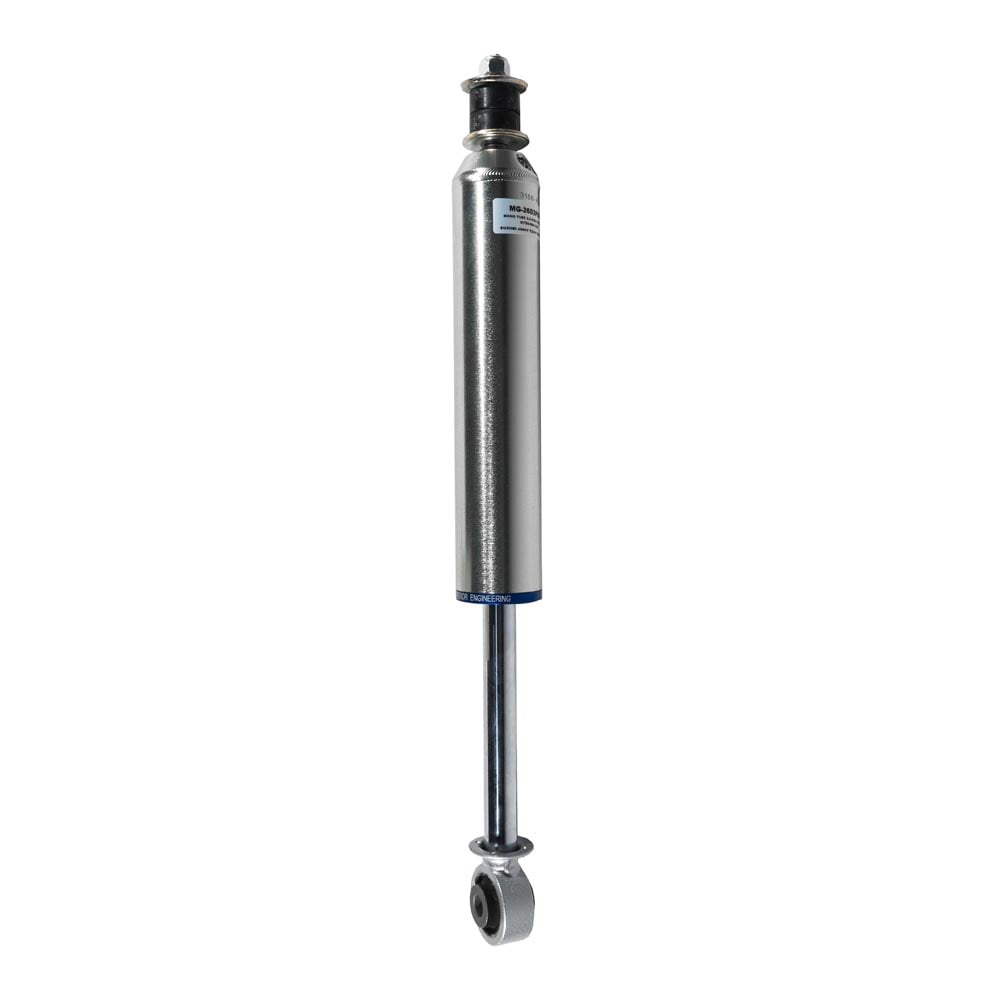
3. Underbody protection
Protecting the Jimny’s underbody from rocks, ruts, and impacts is critical when exploring rugged terrain. The 304 Stainless Steel Transfer Case Guard from Superior Engineering is precision‑cut and folded from 2mm stainless steel, mounting directly without affecting ground clearance or driveline performance. Its durable stainless finish resists corrosion, giving long-lasting protection to the vehicle’s drivetrain in harsh conditions.
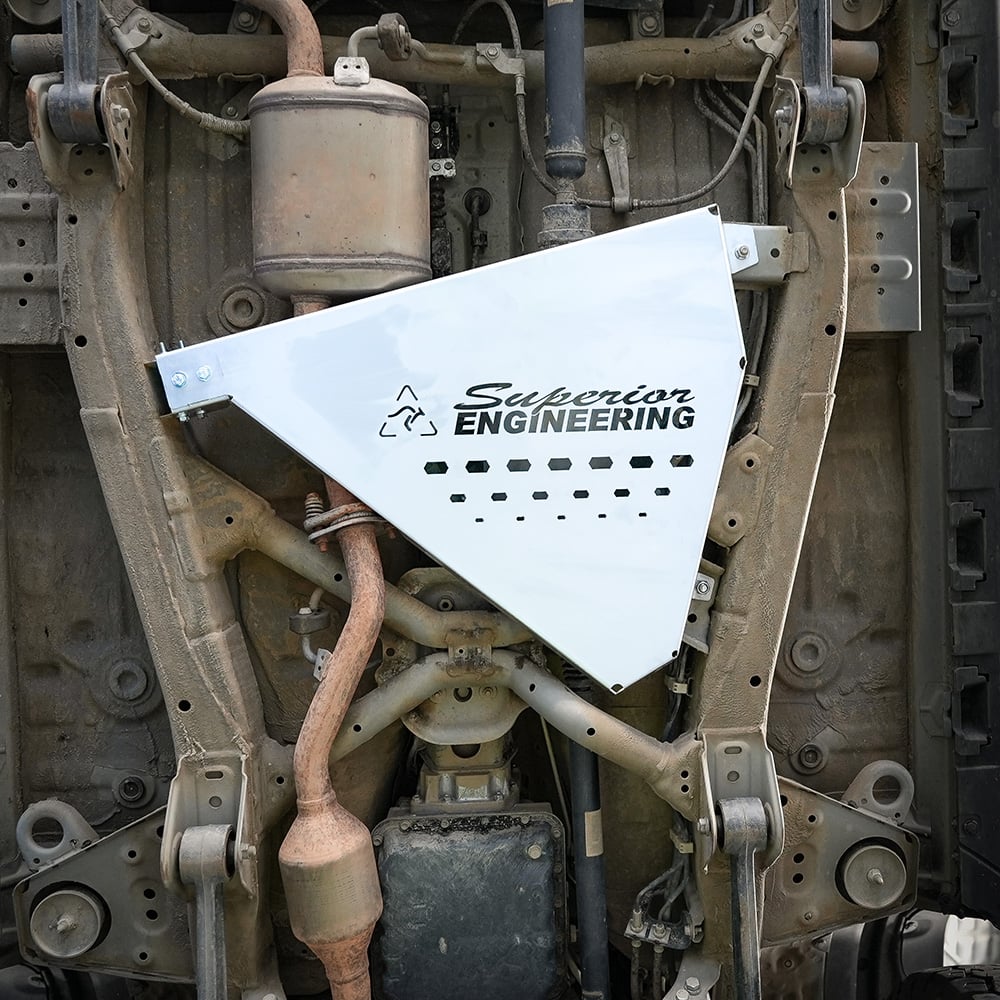
4. Panhard rods
Lifting your Jimny or running larger tyres can throw the rear axle out of alignment, affecting handling and causing uneven tyre wear. The Superior Engineering Adjustable Panhard Rod is machined from solid 1020‑grade steel with a corrosion-resistant finish and allows fine-tuning of axle position for lifts up to four inches. Bolting directly to OEM points, it restores accurate tracking and adds strength where the factory rod is prone to flex, providing serious off-roaders with confidence in rough terrain.
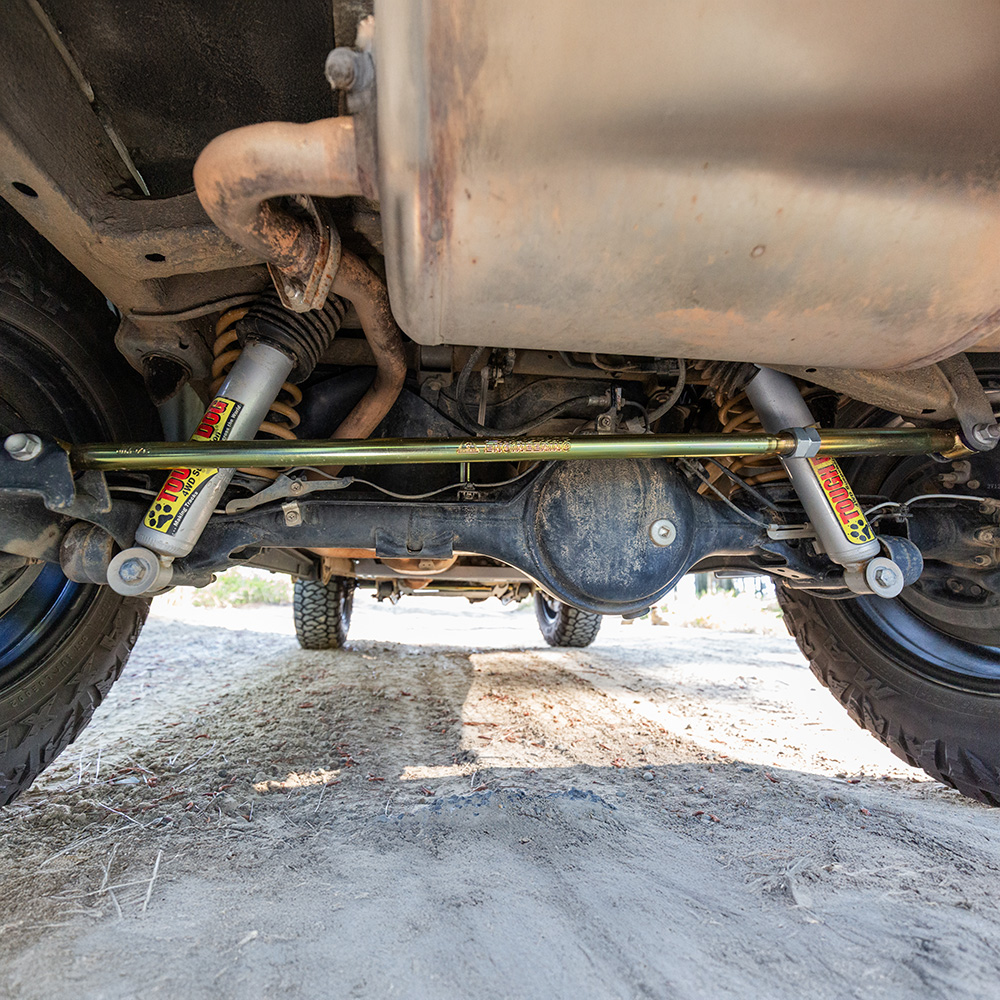
5. Mudflap bracket
Off-roaders need protection from flying debris without sacrificing practicality. Superior Engineering’s Mudflap Brackets provide a robust mounting solution for 280mm mudflaps, with a black powder-coated aluminium bracket that bolts directly to factory rear mounts. For quick removal on demanding trails, the 6061‑T6 alloy Quick‑Disconnect system lets you take flaps off in minutes without tools, keeping your Jimny legal on-road while retaining flexibility off-road.
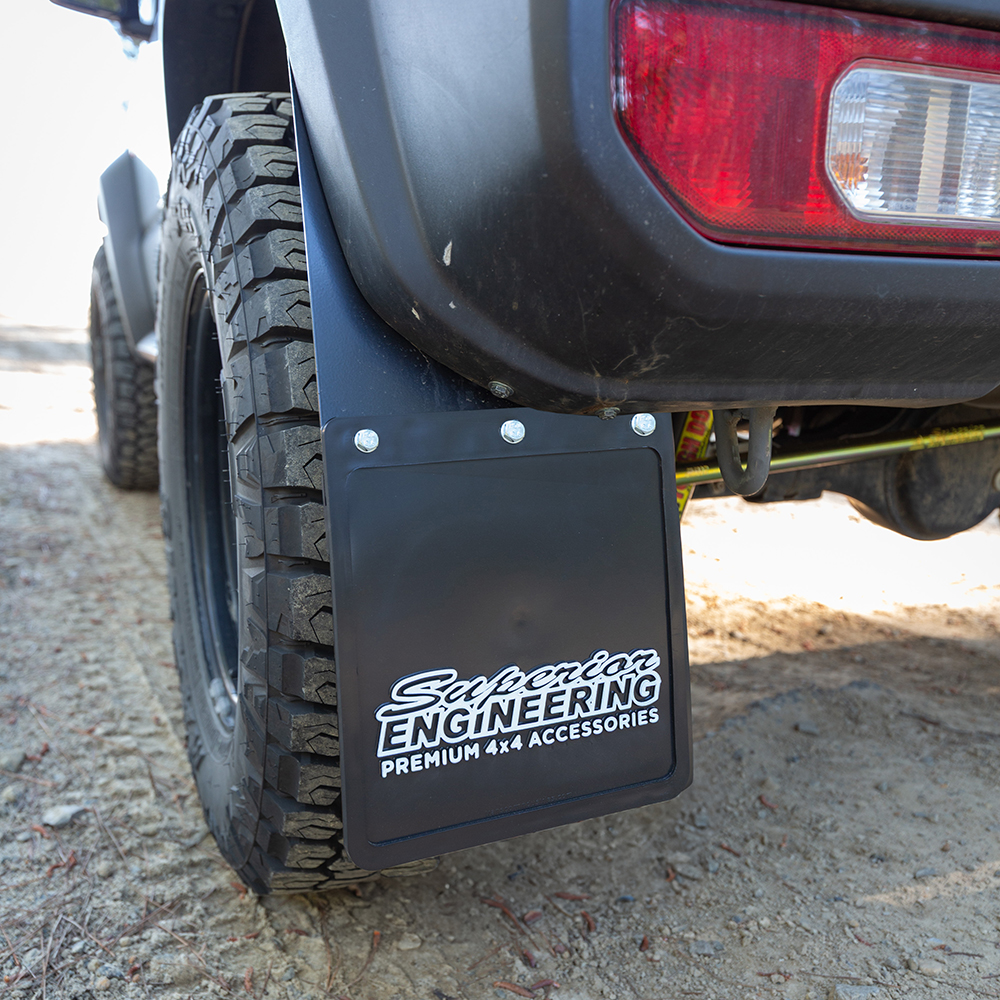
The ninth-generation HiLux was officially revealed earlier this week, available in single-, extra-, and double-cab bodies in WorkMate, SR, SR5, Rogue, and Rugged X grades.
The 4×4 line-up starts with the WorkMate single cab at $45,990 plus ORC, and all 4x4s are automatic only. The 2.8‑litre 1GD‑FTV diesel is now the sole engine across the range, replacing the 2.4‑litre 2GD diesel and 2.7‑litre petrol. All HiLuxes use the same wheelbase and track as previous generations.
Earlier this year, Toyota invited us to sample the new HiLux at the Australian Automotive Research Centre (AARC) in Victoria – and we can finally tell you about it. Our test drive involved a sealed road course (in both a low-spec single-cab and a double-cab SR5), and a challenging off-road track (in an SR5).
Lapping in the unladen tray-back single-cab was a familiar experience. The new dash layout with a 12.3-inch screen is a welcome addition, especially in this low-spec model, and we’re confident users of these low grades will appreciate the added performance of the 2.8‑litre engine. The ride was firm and bouncy with the stiffer suspension tune, and the vehicle didn’t throw up any surprises.
SR5 tested
Stepping into the double-cab SR5 was a big step above the lower-tier spec, with its dual 12.3-inch screens and higher levels of equipment.
On the sealed road, the SR5 felt smoother than the single-cab, and the lighter feel of the electric power steering was evident when compared to the outgoing HiLux’s steering. Switching to the Sport driving mode instantly added more feel and weight to the steering, which I found to be more to my preference.
Being a higher-grade model, the SR5 gets the ‘comfort’ spec suspension calibration, and its compliance and feel were much appreciated over the harsh single-cab. This became more evident when venturing on the unsealed ‘second grade’ road, which was corrugated in places, and the HiLux soaked them up without too much fuss. A stiffer suspension calibration more suited to load bearing would have resulted in the vehicle stepping out on corrugated corners.
Again, I preferred the feel of the EPS in the Sport setting, where it provided better feedback compared to the lighter Normal setting.

Off-road course
Like most of these curated test tracks, the off-road element was relatively tame except for one steep, rutted climb that challenged the HiLux, especially as it became wet due to rain later in the day.
The new HiLux retains relatively long rear axle travel and sharp electronic traction control (ETC) features that have always made it good off-road. The rear differential lock is now standard on all 4×4 models in SR grade and above.
I’ve always found Toyota’s ETC and axle travel have made the HiLux one of the best off-road utes, and the inclusion of the Multi Terrain System (MTS) now gives drivers the option of selecting an off-road mode to best suit the prevailing conditions. I think it will just confuse inexperienced off-road drivers – the old set-up was sufficient for most situations, with the RDL there as backup in trickier terrain.

Heading up the climb the first time on a reasonably dry track, the ETC and wheel travel were all that was needed to make the ascent. Dropping a back wheel into the rut picked up the opposing front, and the HiLux struggled for traction, requiring the rear diff lock to get through.
By the third attempt it was very wet, and if I was alone, I wouldn’t have tried it. This time it slid into the rut early, and the highway tyres were scrabbling for grip straight away, but with the RDL engaged and the ETC operating on the front axle, it eventually scrabbled and slid its way up. An impressive performance for a stock ute on road tyres.
The brief taste behind the wheel showed that the HiLux hasn’t lost any of its capability but has added comfort, softer suspension, and safety with the EPS and new ADAS features.
The 2026 Toyota HiLux will be available at dealerships from December this year.
Pricing
| Variant | 48V | Transmission | Price |
|---|---|---|---|
| WorkMate single cab-chassis | No | AT | $45,990 |
| WorkMate double cab-chassis | No | AT | $52,490 |
| WorkMate double cab pick-up | No | AT | $53,990 |
| SR extra cab-chassis | No | AT | $54,990 |
| SR double cab-chassis | No | MT | $54,990 |
| SR double cab-chassis | Yes | AT | $57,990 |
| SR double cab pick-up | Yes | AT | $59,490 |
| SR5 double cab pick-up | No | MT | $63,990 |
| SR5 double cab-chassis | Yes | AT | $64,490 |
| SR5 double cab pick-up | Yes | AT | $65,990 |
| Rogue double cab pick-up | Yes | AT | $71,990 |
| Rugged X double cab pick-up | Yes | AT | $71,990 |
Custom Lithium has unveiled its all-new Ultra Slim XL Series, the largest single 12V lithium batteries currently available in Australia.
Available in 800Ah, 920Ah, 1120Ah and 1250Ah configurations, the Ultra Slim XL Series is aimed at serious power users running energy-hungry setups in 4×4 canopies, caravans, campers and off-grid systems. Each unit delivers massive storage capacity in a compact, mount-anywhere format, reducing the need for multiple battery banks.
When it comes to caravans, big canopy builds, or fully equipped American truck setups, having this kind of power means longer run times without the need to recharge. It also opens the door to running high-draw luxuries such as coffee machines, air fryers, induction cooktops or fridges with ease – making life off-grid more comfortable and self-sufficient, no matter how remote the destination.
In fact, Kedron Caravans has recently partnered up with Custom Lithium, utilising its XL range of batteries for off-grid living. Kedron already have a few units out in the wild and are in the process of installing more.

Each model features dual terminal outputs to keep wiring clean and balanced – ideal for separating inverter loads from general 12V accessories. A 380A continuous discharge BMS with 1800A protection shutdown provides serious current-handling capability, while reinforced mounting and improved thermal efficiency ensure durability in harsh Australian conditions.
“Over the past year, we kept hearing the same thing, ‘Give me more power.’ So, we did. We built it, tested it, and now it’s ready,” said Cam, Customer Service & Sales Manager at Custom Lithium.
Custom Lithium, a family-owned company from Brendale, Queensland, makes Australian-made lithium batteries built for tough touring conditions. Its range includes 12V Ultra Slim, Slim, and Compact batteries (100–310 Ah), high-capacity caravan/RV batteries (400–620 Ah), 24V/48V system batteries, plus vehicle-specific kits and accessories.
Beyond gear, the company supports local clubs and community projects, reflecting the family values and mateship central to the 4×4 lifestyle. Choosing Custom Lithium means reliable off-grid power and backing a business that prioritises both performance and community.
The Ultra Slim XL Series continues Custom Lithium’s focus on delivering large-scale, Australian-built energy storage solutions that meet the demands of both recreational and commercial users.
Ultra Slim XL Series models:
- 800Ah Ultra Slim XL
- 920Ah Ultra Slim XL
- 1120Ah Ultra Slim XL
- 1250Ah Ultra Slim XL
The new range is available now through Custom Lithium dealers nationwide.
Frustration erupted among 4WD enthusiasts at the Australian 4WD and Adventure Show in Perth, held from November 7 to 9, after several vehicles were issued defect notices while parked at the event.
Videos circulating online – and as seen below, posted to the dirtbornclothing TikTok page – show attendees returning to their cars to find yellow stickers on their windscreens. Defect notices are issued to vehicles deemed unroadworthy and must be inspected at an Authorised Inspection Station within a set timeframe. Police confirmed to Yahoo News that 11 defect notices were issued at the event.
What has particularly irked 4WD owners is that the action was clearly planned in response to the gathering, rather than random patrols. Industry experts have suggested that the move may make some punters hesitant to return to next year’s show – or similar events – out of concern their modified vehicles could be targeted.
Modified 4WDs are often under particular scrutiny because many aftermarket changes can affect roadworthiness. Police typically check lifted suspensions, oversized tyres, steering components, and heavy-duty modifications to ensure they don’t compromise vehicle stability or safety. Accessories such as bullbars, roof racks, winches, and aftermarket lights can also trigger notices if they are unsafe, improperly mounted, or non-compliant with local regulations.
Other common issues include worn brakes, corroded or damaged chassis components, and unroadworthy driveline parts, all of which can be exacerbated by off-road use or modifications. Essentially, any change that affects a vehicle’s geometry, stability, or overall safety can attract a defect notice, making it essential for owners of modified 4x4s to ensure their vehicles meet legal and safety standards before heading to public events or onto the road.
While it’s important to stress the need to keep your modified vehicle within the boundaries of the law, this has a distinct whiff of targeted revenue raising.
Nissan has once again joined forces with Premcar, the Australian engineering company behind the Warrior-spec Patrol and Navara, to develop and test the next-generation Navara for local conditions.
As can be seen in the video (below) released today by Nissan Australia, the program covered a wide range of real-world scenarios and tested the Navara both unladen and at full payload, including towing.
“In Australia and New Zealand, the ute is just part of life – the weekday workhorse, the weekend adventurer, even the school drop-off,” said Tim Davis, Senior Manager Local Product Development and Enhancement at Nissan Australia. “So we can’t just take a ute from another market and assume it’ll fit. It has to be fine-tuned because the conditions we face are totally unique to this part of the world.
“We were co-operating with Premcar to make sure all the ride and handling performance we want from the new Navara is delivered,” added Davis. “They’ve put it through a brutal local tuning and testing program right here in Australia. The aim is simple – to deliver a ute that excels in all scenarios.”
“For almost four decades, we’ve been engineering and thoroughly evaluating cars locally, including generation on generation of utes and off-roaders,” said Warwick Daly, Deputy Director Marketing and Mobility at Nissan Australia. “It’s about ensuring Australians and New Zealanders can have complete confidence – knowing your vehicle will perform when and how you expect it to.
“The new Navara is the product of local engineering experience and know-how. It’s tuned and tested for our customers,” added Daly.
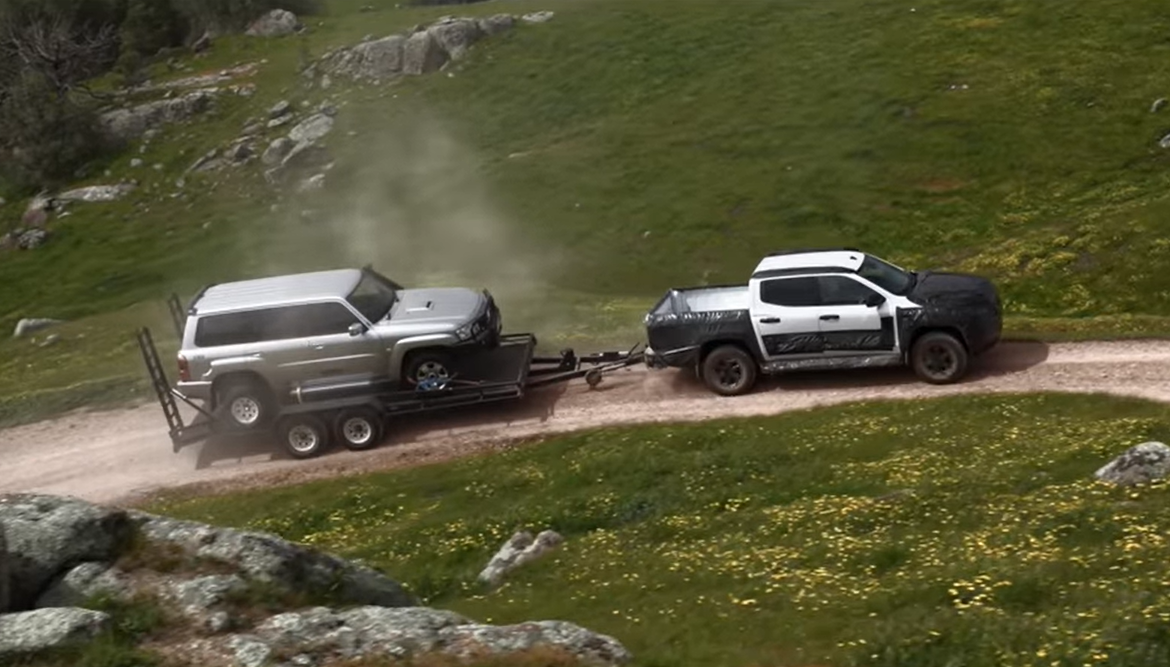
Reports indicate the new model will use a ladder-frame chassis shared with the current Mitsubishi Triton, with both utes assembled at the same plant in Thailand as part of the Renault-Nissan-Mitsubishi Alliance.
Engine choices are expected to focus on diesel, following the Triton’s lead, which delivers 150kW and 470Nm from a four-cylinder turbo-diesel, paired with either a six-speed automatic or manual gearbox. Nissan is also reportedly considering a plug-in hybrid variant for the new Navara.